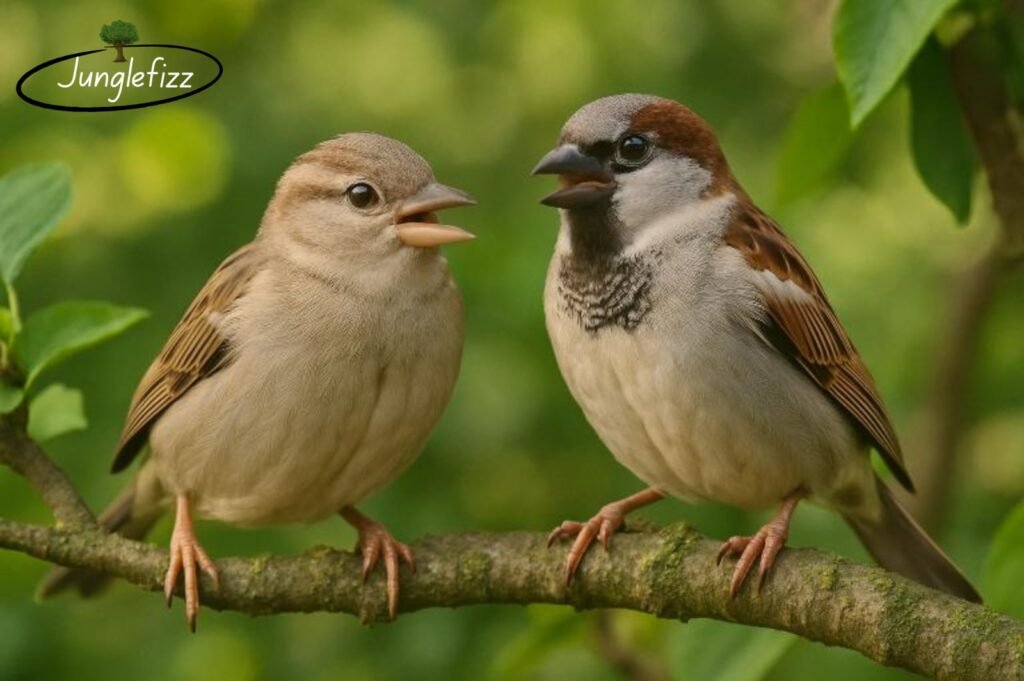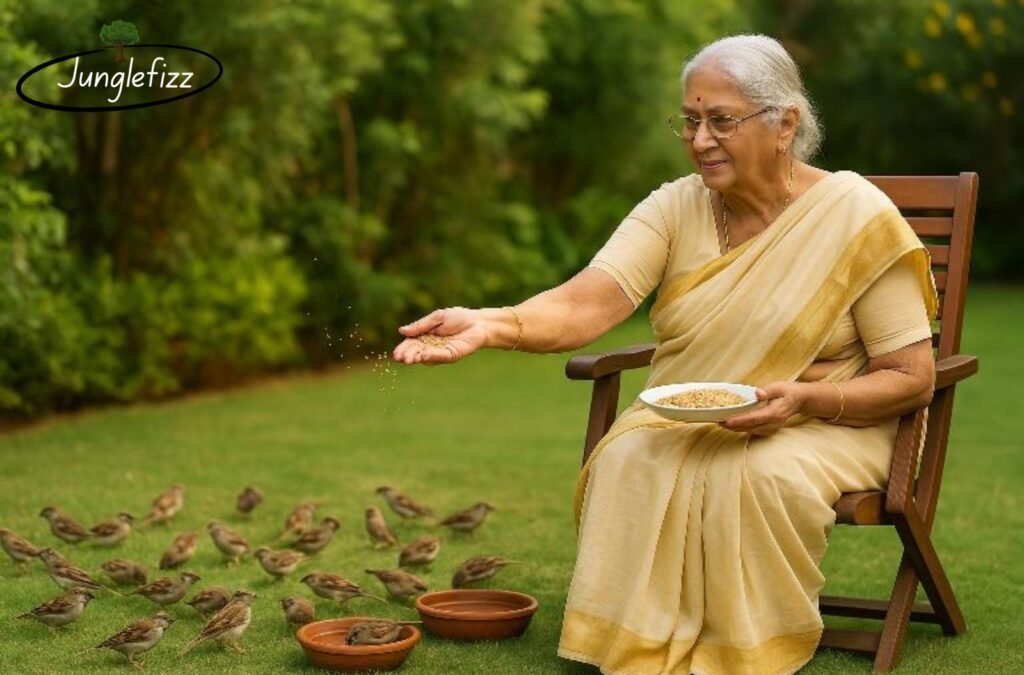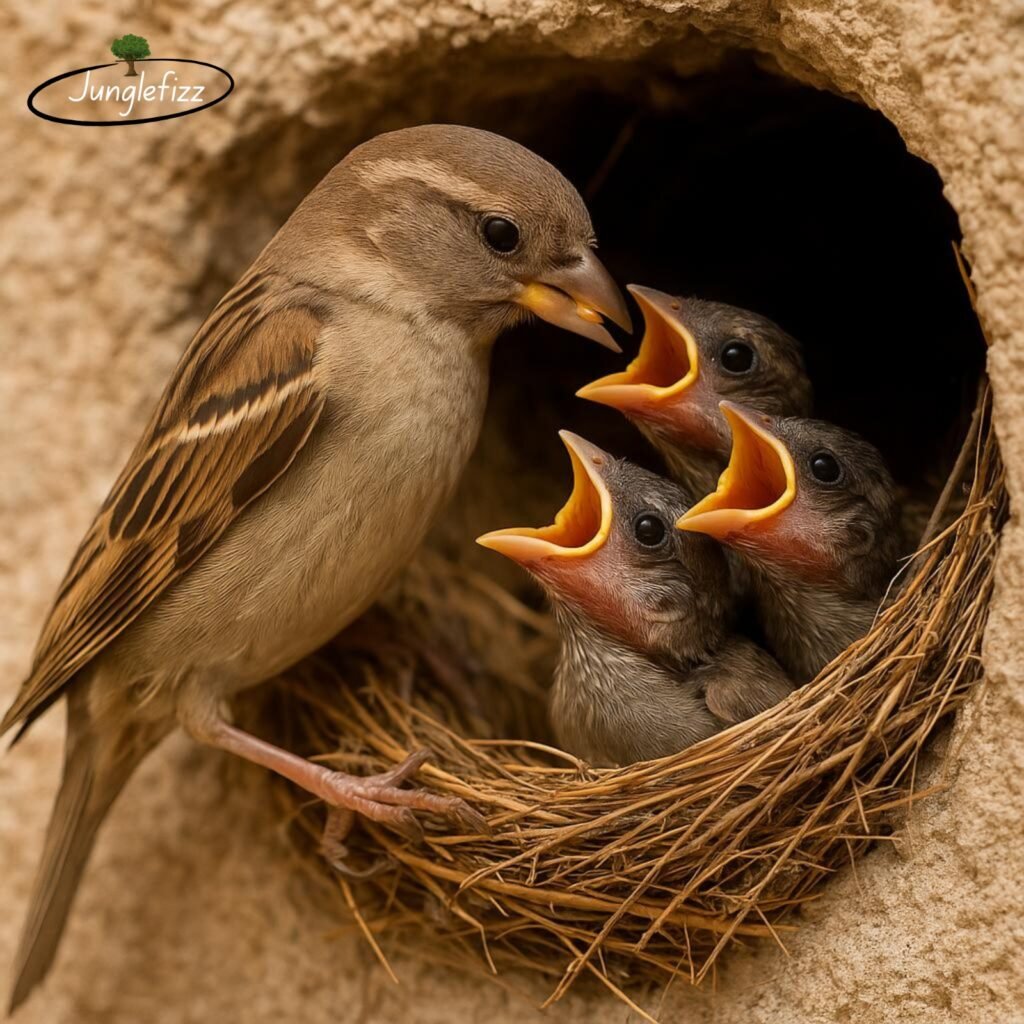🐦Our Ancient Companion
The house sparrow has been our companion for thousands of years. But how far back does this bond go?
Surprisingly, the association between sparrows and human settlements dates back nearly 10,000 years, around the time when agriculture first emerged in the Fertile Crescent.

Since then, this little bird has stayed close to human life, adapting itself to changing environments and lifestyles.
The scientific name of the house sparrow is Passer domesticus. In English, it is called the House Sparrow, but regardless of name, it has always been known as a domestic bird, familiar and beloved.
🏠 A Member of the Household
In our childhood, sparrows would hop around the courtyard, chirping cheerfully. Houses had open ventilators, shelves, and nooks — perfect places for sparrows to build nests. They weren’t just visitors — they were part of our homes.
😔 Why Did the Sparrow Leave Us?
1. Changing Lifestyle: Disappearing Grains and Water

In earlier times, people dried grains in the courtyard, and grandmothers would clean rice and wheat by hand, tossing damaged grains outside — a feast for sparrows. Food and water were easily accessible. Today, our modern lifestyles have eliminated those daily activities, making it harder for sparrows to find nourishment in urban settings.
2. Modern Architecture: No Room for Nests

Traditional homes had ledges, ventilators, and shaded verandas. Modern homes, with sleek, sealed designs, leave no space for sparrows to nest. As our buildings went vertical, the sparrow was left with nowhere to settle.
3. Loss of Natural Habitat
Sparrows also build nests on nearby trees. But with urban sprawl and tree-cutting, their natural nesting sites are rapidly vanishing.
💨 Pollution: A Silent Killer
As our cities have become more polluted, this tiny bird has suffered immensely. From air to sound to chemical pollution, sparrows are under attack on all fronts.
🔊 Noise Pollution
Birds rely on songs for mating, communication, and territorial behavior. But urban noise drowns out their calls. According to studies by the Royal Society for the Protection of Birds (RSPB) and BNHS, this disrupts:

- 🗣 Communication between parents and children.
- 🧬 Reproductive hormone balance, reducing fertility.
- 🧠 Mental and physical development in chicks.
- 🌍 Habitat displacement, as birds flee noisy zones.
🌫 Air Pollution
Polluted air directly harms sparrows’ delicate respiratory systems, making them prone to breathing disorders. Ozone and other airborne toxins also weaken their immune systems, and some studies even show links to reduced reproductive success.
🧪 Chemical Pollution: The Pesticide Crisis
Sparrows feed on grains and insects, both heavily contaminated by modern agriculture. Studies published in Ecotoxicology and field surveys by the Nature Forever Society confirm that exposure to pesticides leads to organ damage, reduced survival, and reproductive failure in birds. In essence, pesticides pose an existential threat to sparrows and other insectivorous birds.
“Pesticides are among the greatest silent killers of biodiversity in modern times.”
📉 How Much Have We Lost?
In urban India, house sparrow populations have declined by up to 80% over the past few decades, according to reports by BNHS and Nature Forever Society. Western Europe and the UK have also seen a 60–90% decline since the 1970s. This isn’t just a decline — it’s an alarm.
“The sparrow’s disappearance is not just the story of a bird — it is the story of our carelessness.”
— Dr. Salim Ali, India’s legendary ornithologist
🌼 Why the House Sparrow Matters
The sparrow is not just a bird — she is a symbol of balance.
✅ Natural Pest Control
Sparrows eat insects, helping control pests and maintaining ecological cleanliness.
✅ Seed Dispersal
By eating and excreting seeds of various crops like millet, sunflower, and berries, sparrows help regenerate plant life.
✅ A Barometer of Environmental Health
The sparrow is incredibly sensitive to environmental change. When she thrives, it’s a sign that the ecosystem is functioning well. When she disappears, it’s a red flag.
⚠️ A Warning Hidden in Silence
In many cities, the chirping of the sparrow has gone silent.
But this silence is not just absence — it’s a warning from nature:
“You lost me — the sparrow — first. If you still don’t wake up, you may lose yourselves too.”
🌈 Hope Still Remains
Not all is lost. Across India, many are taking steps to bring the sparrow back:
- Schools teach children to make nest boxes.
- People are placing grain and water bowls in balconies.
- Urban parks and gardens are being made more bird-friendly.
- And every year, March 20 is celebrated as World Sparrow Day.
💡 What Can We Do?
- Sparrows don’t need forests — just a little compassion.
- Place a clay bowl of water on your window or terrace.
- Add grains like millet, rice, or bajra to another bowl.
- Hang a small wooden nest box.
- Avoid pesticides in your garden or surroundings.
- Teach children about sparrows — let them bond with nature.
🧡 Her Chirping, Our Smile

The house sparrow is more than a bird.
She is a symbol of our lifestyle, our memories, and our conscience.
Losing her is not just losing biodiversity — it’s losing ourselves.
Let’s open our hearts, our courtyards, and our windows.
Let her return.
If you keep some grain and water, she will come.
And with her, she’ll bring joy.
🌿 My Personal Experience
On World Sparrow Day, March 20, 2023, I placed millet and water in small clay bowls on my rooftop. Within two days, sparrows and other birds began visiting. Over time, their numbers increased.

Now, we have a bustling garden where dozens of birds visit daily. We’ve even tied bowls to the lower branches of trees to make the environment safer and more comfortable for them. The joy of seeing them return is unmatched.
🧭 Conclusion
A chirping sparrow means that nature is still kind to us.
But if we continue to ignore these warnings, the day is not far when our survival will be in question.
So, let’s bring her back.
Every time we call her with love, she answers —
With a flutter, a chirp, and a smile.
Smile with birds.


